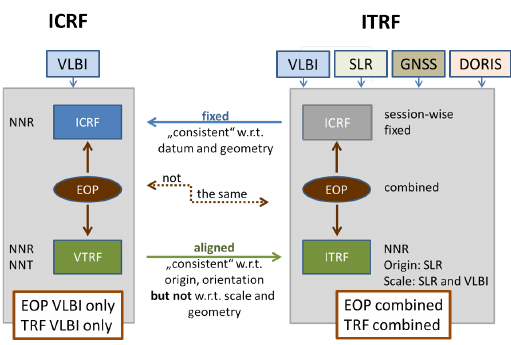Consistent Realization of Terrestrial and Celestial Reference System

According to Resolution 3 (2011) of the International Union of Geodesy and Geophysics (IUGG), highest consistency between the International Celestial Reference Frame (ICRF), the International Terrestrial Reference Frame (ITRF), and the Earth Orientation Parameters (EOP) should be a primary goal in all future realizations of the International Celestial Reference System (ICRS).
The ITRS is realized by positions and velocities of stations on the Earth surface determined from a combination of VLBI, SLR, GNSS and DORIS data. The ICRS is realized by positions of radio sources (quasars or radio galaxies) observed by VLBI. Up to now, the official realizations of ITRS and ICRS are computed independently by different computation centres. Hence, the consistency of the products as requested by the IUGG resolution is not ensured. In order to reach consistency of all related parameters, a joint estimation of the reference frames and the Earth Orientation Parameters (EOP) - which connect the two frames - on the basis of common standards and conventions is required.
For the first time, DGFI-TUM has performed a common realization of ITRS, ICRS, and EOP in accordance to IUGG Resolution R3 (2011) (Seitz M. et al., 2014). The processing incorporated data of Very Long Baseline Interferometry (VLBI), Satellite Laser Ranging (SLR) and Global Navigation Satellite Systems (GNSS), and the solution included station coordinates, quasar coordinates and the EOP, i.e. the coordinates of the terrestrial and the celestial pole (polar motion and nutation), UT1-UTC and their temporal derivative. Current research activities focus on the development of refined strategies for the combination of VLBI, SLR, and GNSS observations at the normal equation level, the optimum parameterization of non-linear station motions and the computation of homogeneous long-term and epoch reference frames.
Related project
Selected Publications

Arcisstraße 21
80333 München